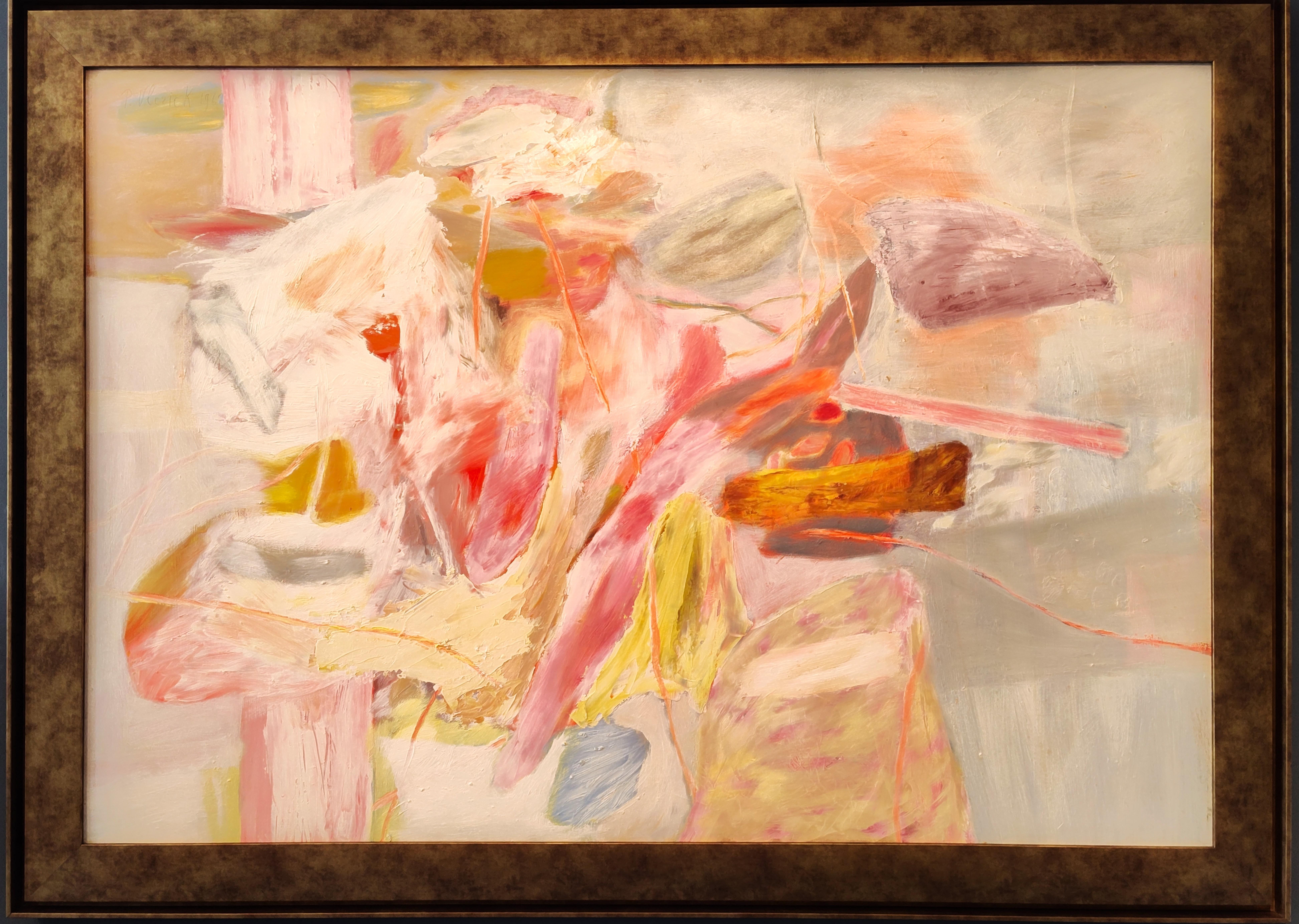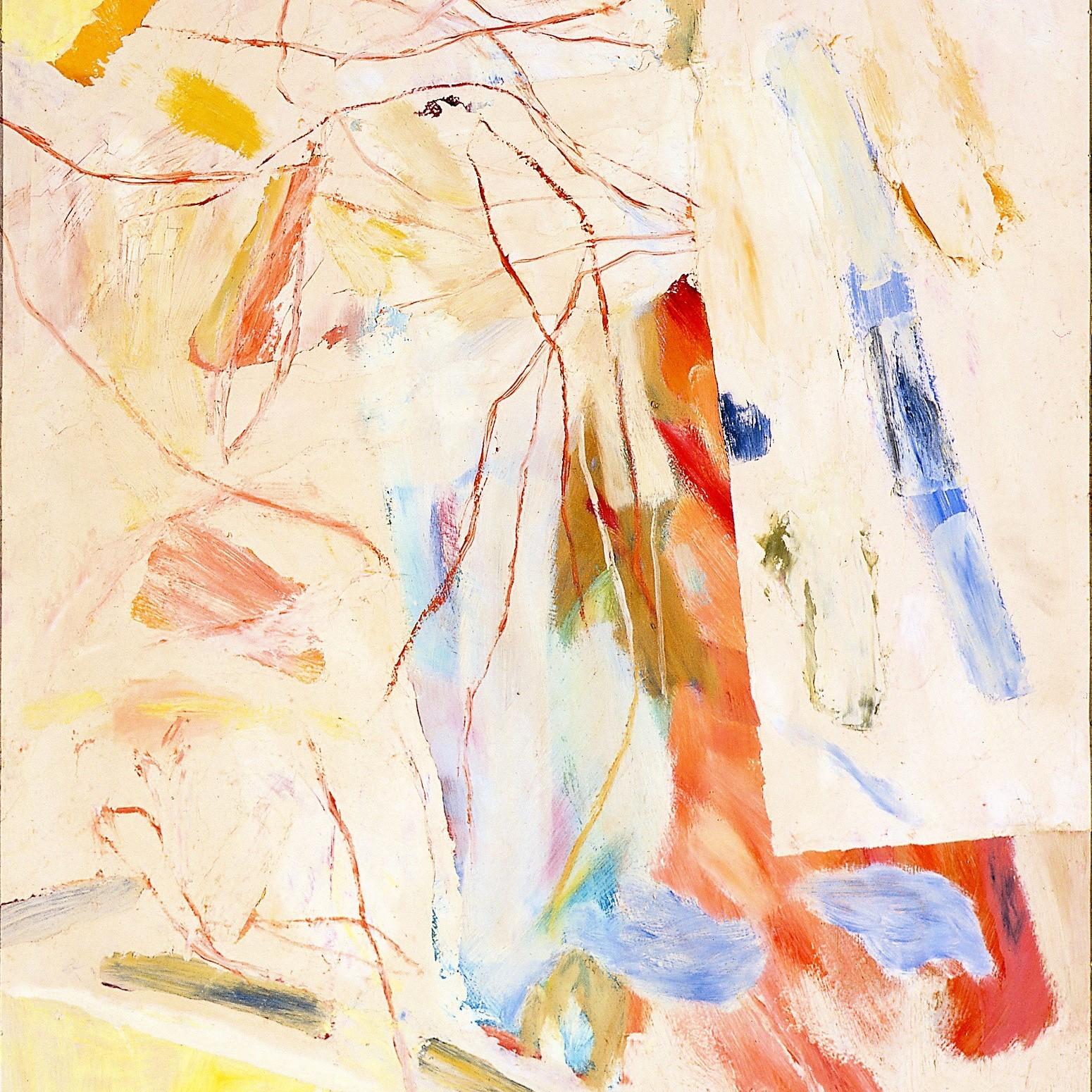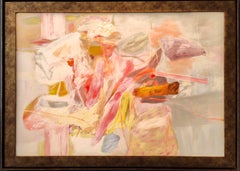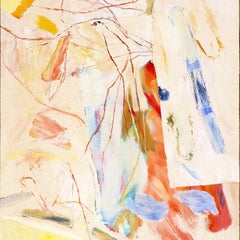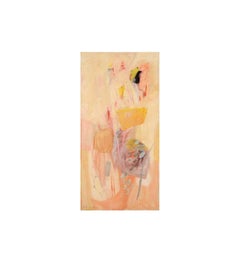Items Similar to Impressionism painting No nightshade Oil on panel by Pierre Vlerick
Video Loading
Want more images or videos?
Request additional images or videos from the seller
1 of 14
Pierre VlerickImpressionism painting No nightshade Oil on panel by Pierre Vlerick
$19,450.50
£14,431.20
€16,250
CA$27,117.21
A$29,400.64
CHF 15,494.08
MX$357,540.51
NOK 192,770.93
SEK 182,296.66
DKK 123,741.68
About the Item
This painting is a perfect example of lyrical abstraction and a choice painting out of the best period of Vlerick's career.
Geen nachtschade (No Nightshade), 1962
Oil on Masonite board
121 x 61 cm (without frame) 136 x 75 cm (framed)
Signed and dated bottom left ‘P. Vlerick 1962’&
with title, signature place and date at the back
Pierre Vlerick’s work shows some resemblance to Willem de Kooning’s. While the Dutch American was famous for the wild manner in which he treated his canvas, Pierre Vlerick showed some more restraint, but making a painting was in any case a slow process of stopping and starting and revising. His exploration is meant to result in a correct proportion of colour fields and streaks, often applied layer upon layer. All his colors have a luminous intensity. It was mainly Bonnard’s colorful work that inspired Vlerick to compose his own singular range of colors of slightly tingling yellows, greens, oranges and bits of blue here and there. Abstraction is emphasized by his use of color. Colors not associated with objects from daily life often dominate the composition: purple, for instance. This is the basis for his continuing abstraction, ending up as color fields combined with organic elements depicted with the vaguest of contours.
Though both artists create a very metropolitan, say even worldly art, their work evokes nature. De Kooning has been called a master of ‘abstract landscape’. The structure of Vlerick’s works, too, is very vegetable and organic. No wonder he referred to his paintings as his ‘gardens’. Neither artist allowed his garden to remain empty: de Kooning created a female figure looking like a cross between a floozy and the mother goddess. Vlerick imagined a woman who is enjoying her body. Vlerick’s approach to abstract art is the same as de Kooning’s; they refuse to paint in a figurative manner, yet at the same time do not wish to renounce referring to reality.
De Kooning once put it very accurately during an interview when he conceded that painting the human figure any longer was absurd(in the post-war period), but also stated that it would be even more absurd not to do it. The only way out of this ambiguous dilemma is the deconstruction of the human figure. Not in order to reject it, but to show it in all its fragility.
Pierre Vlerick’s exceptional artistic talents were already recognized while he was studying at the Ghent Academy (1940-1944) whereupon graduating he received a gold medal.
In 1947-1948 Vlerick enrolls at the “la Grande Chaumière Academy”, a Parisian private academy which attracts lots of foreign artists thanks to the reputation of its most important teachers such as Maurice Denis (1870-1943). Denis was one of the founding fathers of “the Nabis” and is also considered to be the godfather of abstract art by many artists and art critics. Maurice Denis is famous for his quote: "Remember that a painting, before it is any kind of representation, is essentially a flat surface covered with colors in a certain collected order."
At La Grande Chaumière, Vlerick is challenged to develop a pictorial language of his own. Vlerick develops a way to translate the observed reality into visions of color and form, which can be situated somewhere on the axis between the figurative and the abstract. Reality is decomposed and reconstructed into a complete new representation.
After a trip to Spain in 1955 the painter evolves towards the use of brighter colors. At the Brussels World Exhibition of 1958 (Expo 58) Vlerick is for the first time confronted with real works of 17 American artists (William Baziotes, James Brooks, Sam Francis, Arshile Gorky, Adolph Gottlieb, Philip Guston, Grace Hartigan, Franz Kline, Willem de Kooning, Robert Motherwell, Barnett Newman, Jackson Pollock, Mark Rothko, Theodoros Stamos, Clyfford Still, Bradley Walker Tomlin and Jack Tworkov) and he is deeply impressed. This event pushes him even further into the direction of abstraction and from 1959 onwards Pierre Vlerick radically evolves towards a lyrical abstraction. His abstract paintings from the first half of the 1960s are experimental and raw in their treatment of space and surface and bewitching with their use of dazzling colors.
In the early 1960s the artist starts exhibiting abstract impressionist works at international shows such as the Carnegie Institute, (Pittsburgh 1961/1962); The Corcoran Gallery, (Washington D.C.1963) ; Venice Biennale (Belgian Pavilion), (Venice 1964); Musea de Arte Moderna, (Rio de Janeiro,1965).
Vlerick obtains a Fulbright scholarship, which enables him to stay in the States in 1964 and 1968. He also briefly teaches at the Harvard University in Boston. At the same time, Vlerick collaborated in curating the Forum exhibitions in Ghent in 1961-62-63, where the European avant-garde was prominently shown. This allowed him to be in close contact with the artists and their ideas.
To his credit, his work always remained very personal and original. Vlerick’s work is far removed from the explicitness of expressionism, from the sharp delineations of surrealism, from the angular multi-perspectives of cubism or the cool rationality of conceptualism. He is closer to the myopic outlook on the world typical of an impressionist’s observation and depiction of the world. The way he allows bright colours to fertilise one another is not far removed from Fauvism. And with Lyrical Abstraction, he shares the nerve to let compositions run out of control. One thing is resoundingly clear; he belongs to a post-1945 generation that did not feel like surrendering to the constraints of any one style.
- Creator:Pierre Vlerick (1923 - 1999)
- Dimensions:Height: 53.55 in (136 cm)Width: 29.93 in (76 cm)
- Medium:
- Movement & Style:
- Period:
- Condition:
- Gallery Location:Gent, BE
- Reference Number:1stDibs: LU2140212428912
About the Seller
5.0
Vetted Professional Seller
Every seller passes strict standards for authenticity and reliability
Established in 2018
1stDibs seller since 2022
6 sales on 1stDibs
Typical response time: 2 hours
- ShippingRetrieving quote...Shipping from: Gent, Belgium
- Return Policy
Authenticity Guarantee
In the unlikely event there’s an issue with an item’s authenticity, contact us within 1 year for a full refund. DetailsMoney-Back Guarantee
If your item is not as described, is damaged in transit, or does not arrive, contact us within 7 days for a full refund. Details24-Hour Cancellation
You have a 24-hour grace period in which to reconsider your purchase, with no questions asked.Vetted Professional Sellers
Our world-class sellers must adhere to strict standards for service and quality, maintaining the integrity of our listings.Price-Match Guarantee
If you find that a seller listed the same item for a lower price elsewhere, we’ll match it.Trusted Global Delivery
Our best-in-class carrier network provides specialized shipping options worldwide, including custom delivery.More From This Seller
View AllImpressionism painting 4 Oil on panel by Pierre Vlerick (1923 - 1999)
Located in Gent, VOV
This painting is a perfect example of lyrical abstraction and a choice painting out of the best period of Vlerick's career.
Pierre Vlerick’s work shows...
Category
1960s Abstract Impressionist Abstract Paintings
Materials
Masonite, Oil
Impressionism painting 21 Oil On Panels by Pierre Vlerick (1923 - 1999)
Located in Gent, VOV
This painting is a perfect example of lyrical abstraction and a choice painting out of the best period of Vlerick's career.
Signed and titled by the artist.
Pierre Vlerick...
Category
1960s Abstract Impressionist Abstract Paintings
Materials
Masonite, Oil
Abstract Impressionistic painting on board Ineffable by Pierre Vlerick
Located in Gent, VOV
This painting is a perfect example of lyrical abstraction and a choice painting out of the best period of Vlerick's career.
Ineffable, 1962
Oil on Masonite board
91,5 x 61,5 cm (without frame) 93 x 63 cm (framed)
Signed and dated Top Right ‘P. Vlerick 1962’
with title, signature place and date at the back:
Ineffable P. Vlerick Afsnee 1962
Pierre Vlerick’s work shows some resemblance to Willem de Kooning’s. While the Dutch American was famed for the wild manner in which he treated his canvas, Pierre Vlerick showed some more restraint, but making a painting was in any case a slow process of stopping and starting and revising. His exploration is meant to result in a correct proportion of colour fields and streaks, often applied layer upon layer. All his colors have a luminous intensity. It was mainly Bonnard’s colorful work that inspired Vlerick to compose his own singular range of colors of slightly tingling yellows, greens, oranges and bits of blue here and there. Abstraction is emphasized by his use of color. Colors not associated with objects from daily life often dominate the composition: purple, for instance. This is the basis for his continuing abstraction, ending up as color fields combined with organic elements depicted with the vaguest of contours.
Though both artists create a very metropolitan, say even worldly art, their work evokes nature. De Kooning has been called a master of ‘abstract landscape’. The structure of Vlerick’s works, too, is very vegetable and organic. No wonder he referred to his paintings as his ‘gardens’. Neither artist allowed his garden to remain empty: de Kooning created a female figure looking like a cross between a floozy and the mother goddess. Vlerick imagined a woman who is enjoying her body. Vlerick’s approach to abstract art is the same as de Kooning’s; they refuse to paint in a figurative manner, yet at the same time do not wish to renounce referring to reality.
De Kooning once put it very accurately during an interview when he conceded that painting the human figure any longer was absurd(in the post-war period), but also stated that it would be even more absurd not to do it. The only way out of this ambiguous dilemma is the deconstruction of the human figure. Not in order to reject it, but to show it in all its fragility.
Pierre Vlerick’s exceptional artistic talents were already recognized while he was studying at the Ghent Academy (1940-1944) whereupon graduating he received a gold medal.
In 1947-1948 Vlerick enrolls at the “la Grande Chaumière Academy”, a Parisian private academy which attracts lots of foreign artists thanks to the reputation of its most important teachers such as Maurice Denis (1870-1943). Denis was one of the founding fathers of “the Nabis” and is also considered to be the godfather of abstract art by many artists and art critics. Maurice Denis is famous for his quote: "Remember that a painting, before it is any kind of representation, is essentially a flat surface covered with colors in a certain collected order."
At La Grande Chaumière, Vlerick is challenged to develop a pictorial language of his own. Vlerick develops a way to translate the observed reality into visions of color and form, which can be situated somewhere on the axis between the figurative and the abstract. Reality is decomposed and reconstructed into a complete new representation.
After a trip to Spain in 1955 the painter evolves towards the use of brighter colors. At the Brussels World Exhibition of 1958 (Expo 58) Vlerick is for the first time confronted with real works of 17 American artists (William Baziotes, James Brooks, Sam Francis, Arshile Gorky, Adolph Gottlieb, Philip Guston, Grace Hartigan, Franz Kline, Willem de Kooning, Robert Motherwell, Barnett Newman, Jackson Pollock, Mark Rothko, Theodoros Stamos, Clyfford Still, Bradley Walker...
Category
20th Century Abstract Paintings
Materials
Masonite, Oil
Pierre Vlerick +oil on panel, “no belladonna”.
Located in Gent, VOV
Geen nachtschade (No Nightshade), 1962
Oil on Masonite board
121 x 61 cm (without frame) 136 x 75 cm (framed)
Signed and dated bottom left ‘P. Vlerick 1962’&
with title, signatur...
Category
Mid-20th Century Abstract Abstract Paintings
Materials
Oil
The Isle of the Phoenix, Oil on canvas by Pierre Vlerick (1923–1999)
Located in Gent, VOV
In his monumental work *The Isle of the Phoenix* (1963–1965), Pierre Vlerick reaches the pinnacle of his lyrical-abstract period. The canvas, measuring an impressive 200 x 178 cm, gl...
Category
Mid-20th Century Abstract Expressionist Abstract Paintings
Materials
Oil
Calanche rock formations of Corsica, oil on canvas by Paul Justin Marcel Balmigè
Located in Gent, VOV
This luminous coastal landscape, depicting the Calanche rock formations of Corsica, reveals a lesser-known but deeply resonant dimension of Paul Justin Marcel Balmigère’s artistic id...
Category
Mid-20th Century Other Art Style Landscape Paintings
Materials
Oil
You May Also Like
French Expressionist Abstract Oil Painting
By Yvette Dubois Habasque
Located in Cirencester, Gloucestershire
Abstract
by Yvette Dubois-Habasque (1929-2016)
dated verso and signed with initials
oil painting on artists board, unframed
painting measures: 10.75 x 13.75 inches
Stunning origin...
Category
21st Century and Contemporary Abstract Expressionist Abstract Paintings
Materials
Oil
$797 Sale Price
20% Off
French Expressionist Abstract Oil Painting
By Yvette Dubois Habasque
Located in Cirencester, Gloucestershire
Abstract,
by Yvette Dubois-Habasque (1929-2016)
signed with initials and dated verso
oil painting on artists board, unframed
painting measures: 9.5 x 13 inches
Stunning original ab...
Category
21st Century and Contemporary Abstract Expressionist Abstract Paintings
Materials
Oil
$714 Sale Price
20% Off
Parisian Abstract Expressionist Original Oil Painting
By Yvette Dubois Habasque
Located in Cirencester, Gloucestershire
Stunning original oil painting by the French abstract artist, Yvette Dubois-Habasque (1929-2016). The painting has excellent provenance having come from the artists studio sale in Pa...
Category
Late 20th Century Abstract Expressionist Abstract Paintings
Materials
Oil
$874 Sale Price
20% Off
French Expressionist Abstract Oil Painting
By Yvette Dubois Habasque
Located in Cirencester, Gloucestershire
Abstract
by Yvette Dubois-Habasque (1929-2016)
signed with initials in the lower right, dated and signed verso
oil painting on artists board, unframed
painting measures: 10.75 x 16....
Category
21st Century and Contemporary Abstract Expressionist Abstract Paintings
Materials
Oil
$764 Sale Price
20% Off
French Expressionist Abstract Oil Painting
By Yvette Dubois Habasque
Located in Cirencester, Gloucestershire
Abstract
by Yvette Dubois-Habasque (1929-2016)
dated verso
oil painting on artists board, unframed
painting measures: 13.75 x 9.5 inches
Stunning original abstract painting by the ...
Category
21st Century and Contemporary Abstract Expressionist Abstract Paintings
Materials
Oil
$764 Sale Price
20% Off
French 20th Century Vibrant Abstract Expressionist Still Life Oil Painting
Located in Cirencester, Gloucestershire
Abstract Expressionist Composition
by Gilbert Pelissier (French born 1924)
oil painting on canvas, unframed
canvas size: 16.5 x 13 inches
condition: overall very good, a few minor s...
Category
Late 20th Century Abstract Expressionist Abstract Paintings
Materials
Canvas, Oil
More Ways To Browse
Theodoros Stamos
Robert Newman
Jack Walker
Bradley Tomlin
Bradley Walker Tomlin
Chrysler New York
Sewing Painting
Abstract Art Triangles
Abstract Expressionist City
Abstract Sunrise Painting
Abstract Tropical
Female Abstract Expressionist
Original Art Initials K A
1964 Worlds Fair
Alice Carr
Jim Stuckenberg
Ricardo De Silva
Self Portrait Abstract
